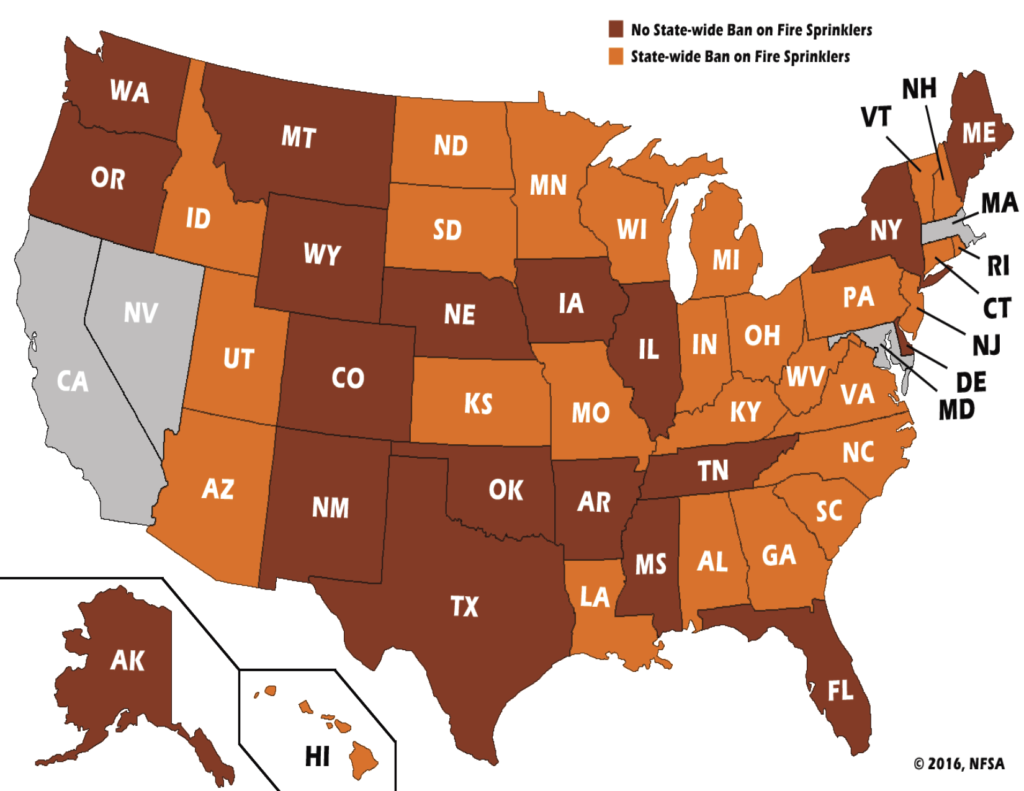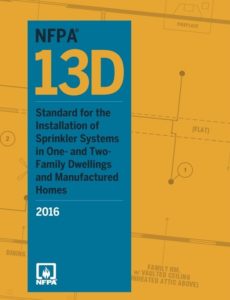Ring in the New Year with a Bang, Not a Ban

As we approach the start of a new year, it’s worth taking stock of what we might do better. In many ways, the past year was marked by unprecedented division, including in local and regional sprinkler codes. As the map here shows, some states had great success (brown) and were able to pass lifesaving fire sprinkler codes. But others’ worthy efforts were hampered by anti-sprinkler-code forces (orange).
Why are sprinkler advocates in half the country stymied? Because in the last decade more than $500 million was funneled from the housing industry into state politics, in the form of political contributions and lobbying efforts designed to keep sprinklers out of codes (ProPublica). The result is that today, half of our states can adopt fire sprinkler codes as they see fit. Fire sprinklers installed in one- and two-family new construction homes is banned from code adoptions in the other half of states.
My own state of Illinois went through a tough battle. Fortunately, we were able to hold back a ban and we can adopt at the community and fire district levels. However, we remain vigilant because every adoption is a battle and even on the village/local level we do lose attempts to adopt NFPA 13D ordinances and often have to fight to defend them.
To illustrate how critical it is to hold back these statewide blockades, this year five more towns and districts were added to the list, making it 110 communities – and thousands of residents – in Illinois protected by NFPA 13D requirements.
So looking forward to 2019, I ask you: How can we allow a ban on improving public safety? This is an overreach of our legislative process and it needs to be challenged. The housing industry and real estate associations used politics to work against state code adoption autonomy. We should assume they will use the same strategy in the coming years, with even more money behind it.
We can’t afford to sit back and watch sprinkler codes blocked in even more states. Our first step is to ensure that we have a strong campaign organized against this sort of opposition. That work can’t be shouldered only by the 25 states that have lost their code-making autonomy; it should be bolstered by the states still fortunate enough to make their own code decisions. Let’s unite behind this challenge.
Our Action Plan
It’s time to ban the ban. Let’s work together to make sure that this map evolves to represent better public safety in the coming years. Bear in mind that many of the orange states experienced their sprinkler code bans several legislative cycles ago. And it’s likely the officials who voted have long gone. Do their replacements share their predecessors’ willingness to stifle public will? Do they understand that home fires today become deadly in as few as two minutes? Do they recognize the unmatched protection a sprinklered home affords both residents and responders? The smart money is on the assumption that they need the facts and they need them from you so they can make better decisions going forward.
Whether in the fire service, as code officials, as property owners or representing the sprinkler industry, our first step should be to fully understand the issues ourselves. Once we do that, we can better educate others within our organizations and communities and outside them; and broaden our organization against sprinkler opposition. In every state, and on every level that you can, take action to raise the profile of both the need for home fire sprinklers and the need for strong sprinkler codes. Here are some ways you can get involved:
Fire Sprinkler Initiative
Join your state’s NFPA Fire Sprinkler Initiative coalition. If you don’t already know, educate yourself about what’s going on in your state legislature. Be ready to articulate the need for progressive sprinkler code requirements. Then, help other advocates at the grass roots level understand the issues and get involved.
Legislative Forums
Each state’s fire and building groups convene legislative forums in the fall of the current year to decide what the priority legislative issues will be for the coming year. Find out how you can support this process. Know if your state can enact sprinkler codes, or if your state is targeted for a ban. Learn which local groups have included improving the fire codes in your state’s legislative forums (and if none, can you include them?). Make your voice heard with these powerful groups.
National Home Fire Sprinkler Day
In 2018, NFPA and the Home Fire Sprinkler Coalition launched the first National Home Fire Sprinkler Day. Every community needs improved home fire sprinkler awareness regardless of a state’s code adoption flexibility. Be sure to participate in this state and national event that focuses attention on the unique protection home fire sprinklers provide for residents and responders.
Make a Proclamation
In May, you and your association should join with other fire safety advocates to issue a Proclamation to better protect your state with model fire codes.
Public Education
Grassroots education is powerful, and you have the power to make it happen in your state. Consider hosting a side-by-side burn demonstration to show lawmakers and the public the speed of fire and the power sprinklers have to control it. Host a press conference calling on all of those who voted for a ban in your state to rescind their vote. Utilize local media to explain the danger of a sprinkler code ban and to promote your position and gain new supporters from your coverage area. Use your social media outreach (such as Facebook and Twitter) to reinforce home fire dangers to residents and responders, and the need for home fire sprinklers to make communities safer. HFSC has free resources that you can and should download and share.
Let’s take back the code process, legislative process, and freedom to adopt codes in every state to make fire sprinklers legal. United, we can strive to remove bans against adopting fire sprinkler ordinances. Wouldn’t it be great to see a map of one color, the color of freedom for fire safety and protection across the country?


 110 towns with NFPA 13D (yellow shade in the “City Square Foot List” file) means that this town also protects all new single-family and single-family attached townhomes with residential fire sprinklers. They are among the 110 communities in Illinois that have already followed the recommendations made by FEMA and NFPA by adopting residential fire sprinkler ordinances.
110 towns with NFPA 13D (yellow shade in the “City Square Foot List” file) means that this town also protects all new single-family and single-family attached townhomes with residential fire sprinklers. They are among the 110 communities in Illinois that have already followed the recommendations made by FEMA and NFPA by adopting residential fire sprinkler ordinances.